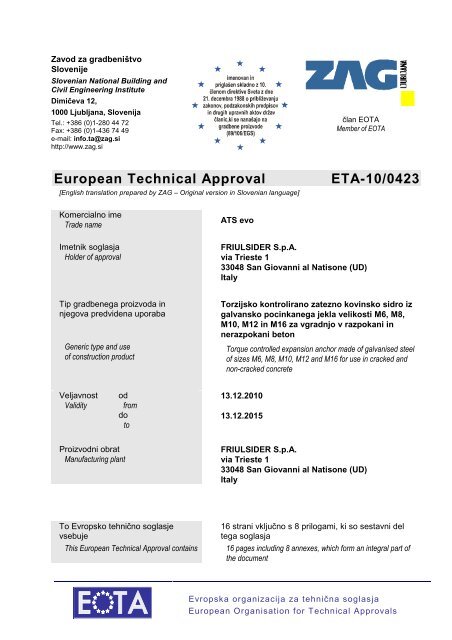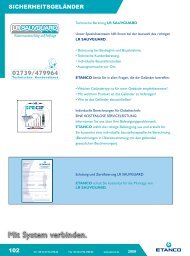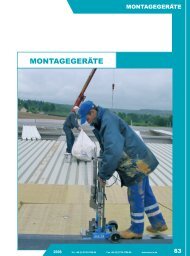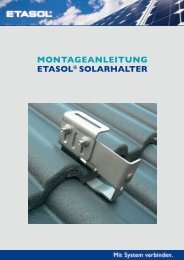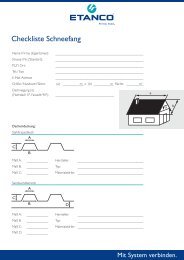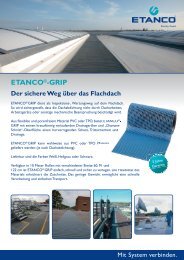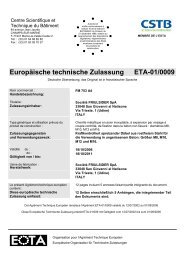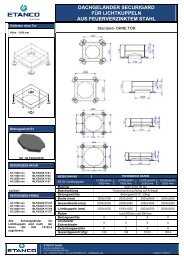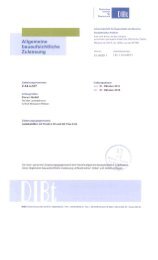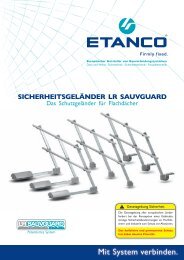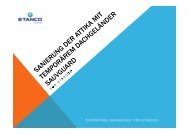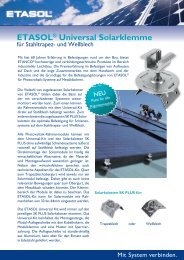ETA-10-0423-ATS evo - Etanco
ETA-10-0423-ATS evo - Etanco
ETA-10-0423-ATS evo - Etanco
Create successful ePaper yourself
Turn your PDF publications into a flip-book with our unique Google optimized e-Paper software.
Zavod za gradbeništvo<br />
Slovenije<br />
Slovenian National Building and<br />
Civil Engineering Institute<br />
Dimičeva 12,<br />
<strong>10</strong>00 Ljubljana, Slovenija<br />
Tel.: +386 (0)1-280 44 72<br />
Fax: +386 (0)1-436 74 49<br />
e-mail: info.ta@zag.si<br />
http://www.zag.si<br />
Ermächtigt<br />
u n d n o t i f i z i e r t<br />
gemäß Artikel <strong>10</strong> der<br />
Richtlinie des Rates vom<br />
21. Dezember 1988 zur Angleichung<br />
der Rechts- und<br />
Verwaltungsvorschriften<br />
d er Mit g lie dstaat en<br />
über Bauprodukte<br />
(89/<strong>10</strong>6/EWG)<br />
član EOTA<br />
Member of EOTA<br />
European Technical Approval <strong>ETA</strong>-<strong>10</strong>/<strong>0423</strong><br />
[English translation prepared by ZAG – Original version in Slovenian language]<br />
Komercialno ime<br />
Trade name<br />
Imetnik soglasja<br />
Holder of approval<br />
Tip gradbenega proizvoda in<br />
njegova predvidena uporaba<br />
Generic type and use<br />
of construction product<br />
Veljavnost od<br />
Validity from<br />
do<br />
to<br />
Proizvodni obrat<br />
Manufacturing plant<br />
To Evropsko tehnično soglasje<br />
vsebuje<br />
This European Technical Approval contains<br />
<strong>ATS</strong> <strong>evo</strong><br />
FRIULSIDER S.p.A.<br />
via Trieste 1<br />
33048 San Giovanni al Natisone (UD)<br />
Italy<br />
Torzijsko kontrolirano zatezno kovinsko sidro iz<br />
galvansko pocinkanega jekla velikosti M6, M8,<br />
M<strong>10</strong>, M12 in M16 za vgradnjo v razpokani in<br />
nerazpokani beton<br />
Torque controlled expansion anchor made of galvanised steel<br />
of sizes M6, M8, M<strong>10</strong>, M12 and M16 for use in cracked and<br />
non-cracked concrete<br />
13.12.20<strong>10</strong><br />
13.12.2015<br />
FRIULSIDER S.p.A.<br />
via Trieste 1<br />
33048 San Giovanni al Natisone (UD)<br />
Italy<br />
16 strani vključno s 8 prilogami, ki so sestavni del<br />
tega soglasja<br />
16 pages including 8 annexes, which form an integral part of<br />
the document<br />
Evropska organizacija za tehnična soglasja<br />
European Organisation for Technical Approvals
Page 2 of <strong>ETA</strong>-<strong>10</strong>/<strong>0423</strong>, issued on 13.12.20<strong>10</strong>, English translation prepared by ZAG<br />
I LEGAL BASES AND GENERAL CONDITIONS<br />
1. This European Technical Approval is issued by the Slovenian National Building and Civil<br />
Engineering Institute (ZAG) in accordance with:<br />
− Council Directive 89/<strong>10</strong>6/EEC of 21 December 1988 on the approximation of laws,<br />
regulations and administrative provisions of Member States relating to construction<br />
products 1 , modified by the Council Directive 93/68/EEC 2 and Regulation (EC)<br />
N o 1882/2003 of the European Parliament and of the Council 3 ,<br />
− Zakon o gradbenih proizvodih (ZGPro) 4 ,<br />
− Common Procedural Rules for Requesting, Preparing and the Granting of European<br />
Technical Approvals set out in the Annex of Commission Decision 94/23/EC 5 ,<br />
− Guideline for European Technical Approval of “Metal Anchors for use in Concrete“,<br />
Part 1 “Anchors in General” and Part 2: Torque controlled expansion anchors”, <strong>ETA</strong>G<br />
001, edition October 1997, amended November 2006.<br />
2. The Slovenian National Building and Civil Engineering Institute (ZAG) is authorised to<br />
check whether the provisions of this European Technical Approval are met. Checking<br />
may take place in the manufacturing plant. Nevertheless, the responsibility for the<br />
conformity of the products with the European Technical Approval and for their fitness for<br />
the intended use remains with the holder of the European Technical Approval.<br />
3. This European Technical Approval is not to be transferred to manufacturers or agents of<br />
manufacturer other than those indicated on page 1; or manufacturing plants other than<br />
those indicated on page 1 of this European Technical Approval.<br />
4. This European Technical Approval may be withdrawn by the Slovenian National Building<br />
and Civil Engineering Institute (ZAG), in particular pursuant to information by the<br />
Commission according to Article 5 (1) of the Council Directive 89/<strong>10</strong>6/EEC.<br />
5. Reproduction of this European Technical Approval including transmission by electronic<br />
means shall be in full. However, partial reproduction can be made with the written consent<br />
of the Slovenian National Building and Civil Engineering Institute (ZAG). In this case<br />
partial reproduction has to be designated as such. Texts and drawings of advertising<br />
brochures shall not contradict or misuse the European Technical Approval.<br />
6. The European Technical Approval is issued by the approval body in its official language.<br />
This version corresponds fully to the version circulated within EOTA. Translations into<br />
other languages have to be designated as such.<br />
1 Official Journal of the European Communities N o L 40, 11.2.1989, p.12<br />
2 Official Journal of the European Communities N o L 220, 30.8.1993, p.1<br />
3 Official Journal of the European Union N o L 284, 31.<strong>10</strong>.2003, p.1<br />
4 Offical Gazette of the Republic of Slovenia, N o 52/00 and N o 1<strong>10</strong>/02<br />
5 Official Journal of the European Communities N o L 17, 20.1.1994, p.34
Page 3 of <strong>ETA</strong>-<strong>10</strong>/<strong>0423</strong>, issued on 13.12.20<strong>10</strong>, English translation prepared by ZAG<br />
II SPECIFIC CONDITIONS OF THE EUROPEAN TECHNICAL APPROVAL<br />
1 Definition of product and intended use<br />
1.1 Definition of product<br />
The <strong>ATS</strong> <strong>evo</strong> in the range of M6, M8, M<strong>10</strong>, M12 and M16 is an anchor made of<br />
galvanised steel, which is placed into a drilled hole and anchored by torque-controlled<br />
expansion.<br />
For the installed anchor see Figure given in Annex 1 and 4.<br />
1.2 Intended use<br />
The anchor is intended to be used for anchorages for which requirements for mechanical<br />
resistance and stability and safety in use in the sense of the Essential Requirements 1<br />
and 4 of Council Directive 89/<strong>10</strong>6/EEC shall be full filled and failure of anchorages made<br />
with these products would compromise the stability of the works, cause risk to human life<br />
and/or lead to considerable economic consequences. The anchor is to be used only for<br />
anchorages subjected to static and quasi-static loading in reinforced or non reinforced<br />
normal weight concrete of strength classes from C20/25 to C50/60 according to EN 206-<br />
1:2003. It may be anchored in cracked and non-cracked concrete.<br />
The anchor may only be used in concrete subject to dry internal conditions.<br />
The anchor my be used for anchorages with requirements related to resistance to fire.<br />
The provisions made in this European Technical Approval are based on an assumed<br />
working life of the anchor of 50 years. The indications given on the working life cannot be<br />
interpreted as a guarantee given by the manufacturer, but are to be regarded only as a<br />
means for choosing the right products in relation to the expected economically reasonable<br />
working life of the works.<br />
2 Characteristics of product and methods of verification<br />
2.1 Characteristics of product<br />
The anchor corresponds to the drawings and provisions given in Annexes 1 to 4. The<br />
characteristic material values, dimensions and tolerances of the anchor not indicated in<br />
these Annexes 3 and 4 shall correspond to the respective values laid down in the<br />
technical documentation 6 of this European Technical Approval. The characteristic anchor<br />
values for the design of anchorage are given in Annexes 5 and 6. The characteristic<br />
anchor values for the design of anchorages regarding resistance to fire are given in<br />
Annexes 7 and 8. They are valid for use in a system that is required to provide a specific<br />
fire resistance class.<br />
Each anchor is marked with the product name, nominal drill hole diameter and maximum<br />
thickness of the fixture.<br />
As an example: FM-<strong>ATS</strong> φ 15/20<br />
6 The technical documentation of this European Technical Approval is deposited at the Slovenian National Building<br />
and Civil Engineering Institute (ZAG) and, as far as relevant for the tasks of the approved bodies involved in the<br />
attestation of conformity procedure, is handed over the approved bodies.
Page 4 of <strong>ETA</strong>-<strong>10</strong>/<strong>0423</strong>, issued on 13.12.20<strong>10</strong>, English translation prepared by ZAG<br />
The anchor shall only be packaged and supplied as a complete unit.<br />
2.2 Methods of verification<br />
The assessment of fitness of the anchor for the intended use in relation to the<br />
requirements for mechanical resistance, stability and safety in use in the sense of the<br />
Essential Requirement 1 and 4 has been made in accordance with the “Guideline for<br />
European Technical Approval of Metal Anchors for use in Concrete”, Part 1 “Anchors in<br />
general” and Part 2 “Torque-controlled expansion anchors”, on the basis of Option 1.<br />
The assessment of the anchor for the intended use in relation to the requirements for<br />
resistance to fire has been made in accordance with the Technical Report TR 020<br />
“Evaluation of anchorages in concrete concerning resistance to fire”.<br />
3 Evaluation and attestation of conformity and CE marking<br />
3.1 System of attestation of conformity<br />
According to the decision 97/463/EC of the European Commission 7 the system 1 of<br />
attestation of conformity applies.<br />
This system of attestation of conformity is defined as follows:<br />
System 1: Certification of the conformity of the product by an approved certification body<br />
on the basis of:<br />
a) tasks for the manufacturer:<br />
(1) factory production control;<br />
(2) further testing of samples taken at the factory by the manufacturer in accordance<br />
with a control plan.<br />
b) tasks for the approved body:<br />
(3) initial type-testing of the product;<br />
(4) initial inspection of factory and of factory production control;<br />
(5) continuous surveillance, assessment and approval of factory production control.<br />
3.2 Responsibilities<br />
3.2.1 Tasks of the manufacturer<br />
3.2.1.1 Factory production control<br />
The manufacturer shall exercise permanent internal control of production of concerned<br />
product. All the elements, requirements and provisions adopted by the manufacturer are<br />
documented in a systematic manner in the form of written policies and procedures,<br />
including records of results performed. This production control system ensures that the<br />
product is in conformity with the European technical approval.<br />
The manufacturer may only use raw materials stated in the technical documentation of<br />
this European technical approval. The incoming raw materials shall be subject to controls<br />
and tests by the manufacturer before acceptance. Check of incoming materials shall<br />
include control of the inspection documents presented by the manufacturer of the raw<br />
7 Official Journal of the European Communities L 198/31 of 25.7.1997
Page 5 of <strong>ETA</strong>-<strong>10</strong>/<strong>0423</strong>, issued on 13.12.20<strong>10</strong>, English translation prepared by ZAG<br />
materials (comparison with nominal values) by verifying dimensions and determining the<br />
material properties, e.g. tensile strength, hardness, surface finish<br />
The manufactured components of the anchor shall be subjected to the following tests:<br />
− Dimensions of the component parts:<br />
screw (thread, lengths, wrench, marking);<br />
sleeve (length, thickness, catch size);<br />
cone (thread, diameters);<br />
hexagonal nut (thread, wrench, height);<br />
washer (diameter, thickness).<br />
− Material properties:<br />
screw (yielding and ultimate tensile strength);<br />
sleeve (hardness);<br />
cone (hardness);<br />
hexagonal nut (proof load or hardness);<br />
washer (hardness).<br />
− Visual control of correct assembly and of completeness of the anchor.<br />
The factory production control shall be in accordance with the “Control Plan” of<br />
13.12.20<strong>10</strong> relating to the European technical approval <strong>ETA</strong>–<strong>10</strong>/<strong>0423</strong> issued on<br />
13.12.20<strong>10</strong>, which is part of the technical documentation of this European technical<br />
approval. The “Control Plan” is laid down in the context of the factory production control<br />
system operated by the manufacturer and deposited at the Slovenian National Building<br />
and Civil Engineering Institute (ZAG).<br />
The results of factory production control shall be recorded and evaluated in accordance<br />
with the provisions of the “Control Plan”.<br />
3.2.1.2 Other tasks of the manufacturer<br />
The manufacturer shall, on the basis of a contract, involve a body which is approved for<br />
the tasks referred to in a section 3.1 in the field of torque-controlled expansion anchors in<br />
order to undertake the actions laid down in section 3.3. For this purpose the “Control<br />
Plan” referred to in sections 3.2.1.1 and 3.2.2 shall be handed over by the manufacturer<br />
to the approved body or bodies involved.<br />
The manufacturer shall make a declaration of conformity, stating that the construction<br />
product is in conformity with the provisions of the European technical approval <strong>ETA</strong>–<br />
<strong>10</strong>/<strong>0423</strong> issued on 13.12.20<strong>10</strong>.<br />
3.2.2 Tasks of notified bodies<br />
The notified body shall perform the:<br />
- initial type testing of the product,<br />
- initial inspection of factory and of factory production control,<br />
- continuous surveillance, assessment and approval of factory production control.<br />
in accordance with the provisions laid down in the “Control plan” of 13.12.20<strong>10</strong>, which is<br />
the part of technical documentation of this European technical approval.<br />
The notified body shall retain the essential points of its actions referred to above and state<br />
the results obtained and conclusions drawn in a written report.<br />
The notified certification body involved by the manufacturer shall issue an EC certificate<br />
of conformity control stating the conformity with the provisions of this European technical<br />
approval.
Page 6 of <strong>ETA</strong>-<strong>10</strong>/<strong>0423</strong>, issued on 13.12.20<strong>10</strong>, English translation prepared by ZAG<br />
In cases where the provisions of the European technical approval and its “Control Plan”<br />
are no longer full filled the certification body shall withdraw the certificate of conformity<br />
and inform the Slovenian National Building and Civil Engineering Institute (ZAG) without<br />
delay.<br />
3.3 CE-Marking<br />
The CE marking shall be affixed on each packaging of anchors. The symbol “CE” shall be<br />
followed by the identification number of the certification body, and be accompanied by the<br />
following additional information:<br />
− identification number of the certification body;<br />
− name and identifying mark of the producer and manufacturing plant;<br />
− the last two digits of the year in which CE – marking was affixed;<br />
− number of the EC certificate of conformity;<br />
− number of the European Technical Approval;<br />
− use category <strong>ETA</strong>G 001 – 2 (Option 1);<br />
− size of the anchor.<br />
4 Assumptions under which the fitness of the product for the intended use<br />
was favourably assessed<br />
4.1 Manufacturing<br />
The European technical approval is issued for the product on the basis of agreed<br />
data/information, deposited with the Slovenian National Building and Civil Engineering<br />
Institute (ZAG), which identifies the product that has been assessed and judged. Changes<br />
to the product or production process, which could result in this deposited data/information<br />
being incorrect, should be notified to the Slovenian National Building and Civil<br />
Engineering Institute (ZAG) before the changes are introduced. The Slovenian National<br />
Building and Civil Engineering Institute (ZAG) will decide whether or not such changes<br />
affect the <strong>ETA</strong> and consequently the validity of the CE marking on the basis of the <strong>ETA</strong><br />
and if so whether further assessment or alternations to the <strong>ETA</strong>, shall be necessary.<br />
4.2 Installation<br />
4.2.1 Design of anchorages<br />
The fitness of the anchors for the intended use is given under the following conditions:<br />
The anchorages are designed in accordance with the “Guideline for European Technical<br />
Approval of Metal Anchors for use in Concrete”, Annex C, Method A for torque controlled<br />
expansion anchors under the responsibility of an engineer experienced in anchorages<br />
and concrete work.<br />
Verifiable calculation notes and drawings are prepared taking account of the loads to be<br />
anchored.<br />
The position of the anchor is indicated on the design drawings (e.g. position of the anchor<br />
relative to reinforcement or to support, etc.).<br />
The design of anchorages under fire exposure has to consider the conditions given in the<br />
Technical Report TR 020 “Evaluation of anchorages in concrete concerning resistance to<br />
fire”. The relevant characteristic anchor values are given in Annex 7 Table 9 for<br />
resistance to fire under tension loads and in Annex 8 Table <strong>10</strong> for resistance to fire under<br />
shear loads. The design methods covers anchors with a fire attack from one side only. If
Page 7 of <strong>ETA</strong>-<strong>10</strong>/<strong>0423</strong>, issued on 13.12.20<strong>10</strong>, English translation prepared by ZAG<br />
the fire attack is from more then one side, the design method may be taken only if edge<br />
distance of the anchor is c ≥ 300 mm.<br />
4.2.2 Installation of anchors<br />
The fitness for use of the anchor can only be assumed if the following conditions are met:<br />
− Anchor installation carried out by appropriately qualified personnel and under the<br />
supervision of the person responsible for technical matters on the site.<br />
− Use of the anchor only as supplied by the manufacturer without exchanging the<br />
components of an anchor.<br />
− Anchor installation in accordance with the manufacturer’s specifications and drawings<br />
using the appropriate tools.<br />
− Thickness of the fixture corresponding to the range of required thickness values for the<br />
type of anchor.<br />
− Checks before placing the anchor to ensure that the strength class of the concrete in<br />
which the anchor is to be placed is in the rang given and is not lower that of the<br />
concrete to which the characteristic loads apply for.<br />
− Check of concrete being well compacted, e.g. without significant voids.<br />
− Cleaning of the hole of drilling dust.<br />
− Anchor installation ensuring the specified embedment depth.<br />
− Keeping of the edge distance and spacing to the specified values without minus<br />
tolerances.<br />
− Positioning of the drill holes without damaging the reinforcement.<br />
− In case of aborted hole: new drilling at a minimum distance away of twice the depth of<br />
the aborted hole or smaller distance if the aborted drill hole is filled with high strength<br />
mortar and if under shear or oblique tension load it is not to the anchor in the direction<br />
of load application.<br />
− Application of the torque moment given in Annex 4 using a calibrated torque wrench.
Page 8 of <strong>ETA</strong>-<strong>10</strong>/<strong>0423</strong>, issued on 13.12.20<strong>10</strong>, English translation prepared by ZAG<br />
4.2.3 Responsibility for the manufacturer<br />
Leading expert:<br />
It is in the responsibility of the manufacturer to ensure that the information on the specific<br />
conditions according to 1 and 2 including Annexes referred to 4.2.1, 4.2.2 is given to<br />
those who are concerned. This information may be made by reproduction of the<br />
respective parts of the European Technical Approval. In addition, all installation data shall<br />
be shown clearly on the packaging and/or on an enclosed instruction sheet, preferably<br />
using illustration.<br />
The minimum data required are:<br />
− drill bit diameter;<br />
− thread diameter;<br />
− maximum thickness of the fixture;<br />
− minimum installation depth;<br />
− torque moment;<br />
− information on the installation procedure, including cleaning of the hole, preferably by<br />
means of an illustration;<br />
− reference to any special installation equipment needed;<br />
− identification of the manufacturing batch.<br />
All data shall be presented in a clear and explicit form.<br />
Dušica Drobnič, M.Sc., (Civ.Eng.)<br />
Service for Technical Approvals:<br />
Franc Capuder, M.Sc., (Civ.Eng.)
Page 9 of <strong>ETA</strong>-<strong>10</strong>/<strong>0423</strong>, issued on 13.12.20<strong>10</strong>, English translation prepared by ZAG<br />
Type B with threaded bar Type SK with<br />
countershunk screw<br />
<strong>ATS</strong> <strong>evo</strong><br />
Product and intended use<br />
Type S with screw<br />
Annex 1<br />
Sleeve for M16 size<br />
of the European Technical<br />
Approval<br />
<strong>ETA</strong>–<strong>10</strong>/<strong>0423</strong><br />
(SH)<br />
Marking: Identification mark of the producer - trade name of the anchor<br />
nominal drill hole diameter / max thickness of fixture<br />
(and line for minimum embedment and max thickness of fixture)<br />
e.g.: FM-<strong>ATS</strong><br />
Ø15/20<br />
L = length of the anchor (mm)<br />
tfix = thickness of fixture (mm)<br />
d0 = nominal drill hole diameter (mm)<br />
hnom = minimum installation depth (mm)<br />
hef = effective anchorage depth (mm)<br />
df = diameter of clearance hole in the fixture (mm)<br />
h1 = depth of drill hole (mm)<br />
hmin = minimum thickness of the concrete member (mm)<br />
Tinst = torque moment (Nm)
Page <strong>10</strong> of <strong>ETA</strong>-<strong>10</strong>/<strong>0423</strong>, issued on 13.12.20<strong>10</strong>, English translation prepared by ZAG<br />
<strong>ATS</strong> <strong>evo</strong>-S<br />
<strong>ATS</strong> <strong>evo</strong>-B<br />
<strong>ATS</strong> <strong>evo</strong>-SK<br />
1 Cone<br />
2 Expansion sleeve<br />
3 Plastic sleeve<br />
4 Distance sleeve<br />
5 Washer<br />
6 Hexagonal screw<br />
7 Hexagonal nut<br />
8 Threaded bar<br />
9 Countersunk screw<br />
1 2 3 4 5 6 (6)<br />
<strong>ATS</strong> <strong>evo</strong><br />
Product and components<br />
9<br />
7 8<br />
Annex 2<br />
(type SH)<br />
of the European Technical<br />
Approval<br />
<strong>ETA</strong>–<strong>10</strong>/<strong>0423</strong>
Page 11 of <strong>ETA</strong>-<strong>10</strong>/<strong>0423</strong>, issued on 13.12.20<strong>10</strong>, English translation prepared by ZAG<br />
Table 1: Dimensions<br />
Anchor size M6 M8 M<strong>10</strong> M12 M16<br />
Nominal diameter of anchor dnom [mm] <strong>10</strong> 12 15 18 24<br />
Minimum installation depth hnom ≥ [mm] 60 70 80 <strong>10</strong>0 115<br />
Length of the anchor L [mm] tfix + 60 tfix + 70 tfix + 80 tfix + <strong>10</strong>0 tfix + 115<br />
Thickness of<br />
the fixture<br />
Type S (SH) /B tfix,min [mm] 0 0 0 0 0<br />
Type SK tfix,min [mm] 5 6 7 8 -<br />
Type S (SH)/B/SK tfix,max [mm] 200 250 300 350 400<br />
Nominal diameter of the head of the countersunk<br />
screw dsk [mm]<br />
Table 2: Materials<br />
Part of anchor Material<br />
1 Cone hardened steel EN <strong>10</strong>087<br />
17 21 26 31 -<br />
2 Expansion sleeve M6÷M12 hardened steel EN <strong>10</strong>132 1) - M16 steel EN <strong>10</strong>087 1)<br />
3 Plastic sleeve Pa6 ISO 1874/1<br />
4 Distance sleeve Steel EN <strong>10</strong>025 1)<br />
5 Washer Steel EN <strong>10</strong>139 1)<br />
6 Hexagon screw Steel grade 8.8 EN ISO 898/1 1) (DIN 931 -DIN 933 - type SH=head large)<br />
1) - 2)<br />
7 Hexagonal nut Steel grade 8 EN ISO 898/2 1) (DIN 934)<br />
8 Threaded bar Steel grade 8.8 EN ISO 898/1 1)<br />
9 Countershunk screw Steel grade 8.8 EN ISO 898/1 1)<br />
1) zincplated 5µm according to EN ISO 4042<br />
2) functional coating<br />
<strong>ATS</strong> <strong>evo</strong><br />
Dimensions of anchors and materials<br />
Annex 3<br />
of the European Technical<br />
Approval<br />
<strong>ETA</strong>–<strong>10</strong>/<strong>0423</strong>
Page 12 of <strong>ETA</strong>-<strong>10</strong>/<strong>0423</strong>, issued on 13.12.20<strong>10</strong>, English translation prepared by ZAG<br />
Table 3: Installation data<br />
Anchor size M6 M8 M<strong>10</strong> M12 M16<br />
Nominal drill hole diameter d0 [mm] <strong>10</strong> 12 15 18 24<br />
Cutting diameter of drill bit dcut ≤ [mm] <strong>10</strong>,45 12,50 15,5 18,5 24,55<br />
Depth of drill hole h1 ≥ [mm] 75 85 95 115 130<br />
Minimum installation depth hnom ≥ [mm] 60 70 80 <strong>10</strong>0 115<br />
Effective anchorage depth hef [mm] 49 59 67 88 99<br />
Diameter of clearance hole in the fixture df ≤ [mm] 12 14 17 20 26<br />
Length of the anchor L [mm] tfix + 60 tfix + 70 tfix + 80 tfix + <strong>10</strong>0 tfix + 115<br />
Torque moment Tinst [Nm] <strong>10</strong> 20 45 80 150<br />
Table 4: Minimum thickness of concrete member spacing, and edge distances<br />
Anchor size M6 M8 M<strong>10</strong> M12 M16<br />
Minimum thickness of the concrete member hmin [mm] <strong>10</strong>0 120 140 180 200<br />
Minimum spacing<br />
Minimum edge distance<br />
<strong>ATS</strong> <strong>evo</strong><br />
Installation data<br />
smin [mm] 50 60 70 80 <strong>10</strong>0<br />
for c [mm] ≥ 75 90 <strong>10</strong>0 150 200<br />
cmin [mm] 50 60 70 80 <strong>10</strong>0<br />
for s ≥ [mm] 75 90 <strong>10</strong>0 150 200<br />
Annex 4<br />
of the European Technical<br />
Approval<br />
<strong>ETA</strong>–<strong>10</strong>/<strong>0423</strong>
Page 13 of <strong>ETA</strong>-<strong>10</strong>/<strong>0423</strong>, issued on 13.12.20<strong>10</strong>, English translation prepared by ZAG<br />
Table 5: Characteristic values of resistance to tension loads of design method A<br />
M6 M8 M<strong>10</strong> M12 M16<br />
Steel failure<br />
Characteristic resistance<br />
Partial safety factor<br />
NRk,s<br />
1)<br />
γMs<br />
[kN]<br />
[-]<br />
16 29 46<br />
1,5<br />
67 126<br />
Pullout failure<br />
Characteristic resistance in non-cracked<br />
concrete C20/25<br />
NRk,p [kN]<br />
2) 2) 2) 2)<br />
Characteristic resistance cracked concrete<br />
C20/25<br />
NRk,p [kN] 9 12 16 25<br />
Partial safety factor<br />
1)<br />
γMp<br />
[-] 1,5 3)<br />
Concrete cone failure and splitting failure<br />
Effective anchorage depth hef [mm] 49 59 67 88 99<br />
Characteristic spacing scr,N = scr,sp [mm] 3 x hef<br />
Characteristic edge distance ccr,N = ccr,sp<br />
1)<br />
[mm]<br />
[-]<br />
1,5 x hef<br />
1,5 3)<br />
Partial safety factor γMc = γMSp<br />
1) In absence of other national regulation<br />
2) Pullout failure not decisive<br />
3) The partial safety factor is including γ2 = 1,0<br />
Increasing factor for NRk,p<br />
for cracked and non-cracked concrete<br />
Table 6: Displacement under tension load<br />
M6 M8 M<strong>10</strong> M12 M16<br />
ψc C30/37 [-] 1,22<br />
ψc C40/50 [-] 1,41<br />
ψc C50/60 [-] 1,55<br />
C20/25 C50/60<br />
Non-cracked concrete M6 M8 M<strong>10</strong> M12 M16 M6 M8 M<strong>10</strong> M12 M16<br />
Tension load N [kN] 7,7 <strong>10</strong>,9 13,2 19,8 23,6 7,7 13,9 20,4 30,7 36,6<br />
Short term displacement δN0 [mm] 0,47 0,81 0,30 0,25 0,20 0,68 1,06 0,60 0,54 0,40<br />
Long term displacement δN∞ [mm] 2,38 2,49 1,99 1,12 2,15 2,38 2,49 1,99 1,12 2,15<br />
Cracked concrete M6 M8 M<strong>10</strong> M12 M16 M6 M8 M<strong>10</strong> M12 M16<br />
Tension load N [kN] 4,3 5,7 7,6 11,9 16,9 6,6 8,9 11,8 18,5 26,2<br />
Short term displacement δN0 [mm] 1,21 0,83 1,25 0,98 0,96 1,40 1,39 0,93 1,36 1,33<br />
Long term displacement δN∞ [mm] 2,38 2,49 1,99 1,12 2,15 2,38 2,49 1,99 1,36 2,15<br />
<strong>ATS</strong> <strong>evo</strong><br />
Design method A: characteristic values of resistance to<br />
tension loads and displacements<br />
Annex 5<br />
of the European Technical<br />
Approval<br />
<strong>ETA</strong>–<strong>10</strong>/<strong>0423</strong><br />
2)<br />
2)
Page 14 of <strong>ETA</strong>-<strong>10</strong>/<strong>0423</strong>, issued on 13.12.20<strong>10</strong>, English translation prepared by ZAG<br />
Table 7: Characteristic values of resistance to shear loads of design method A<br />
M6 M8 M<strong>10</strong> M12 M16<br />
Steel failure without lever arm<br />
Characteristic resistance<br />
Partial safety factor<br />
VRk,s<br />
1)<br />
γMs<br />
[kN]<br />
[-]<br />
14 26 42<br />
1,25<br />
50 97<br />
Steel failure with lever arm<br />
Characteristic resistance M 0<br />
Partial safety factor<br />
Rk,s<br />
1)<br />
γMs<br />
[Nm]<br />
[-]<br />
12 30 60<br />
1,25<br />
<strong>10</strong>5 266<br />
Concrete pry - out failure<br />
Factor in equation (5.6) of <strong>ETA</strong>G, Annex C, §<br />
5.2.3.3.<br />
k [-] 1,0 2,0<br />
1) 2)<br />
γMc<br />
1,5<br />
Concrete edge failure<br />
Effective length of anchor in shear loading lf [mm] 49 59 67 88 99<br />
Diameter of the anchor<br />
Partial safety factor<br />
dnom<br />
1)<br />
γMc<br />
[mm]<br />
[-]<br />
<strong>10</strong> 12 15<br />
2)<br />
1,5<br />
18 24<br />
1) In absence of other national regulations.<br />
2) The partial safety factor is including γ2 = 1,0.<br />
Table 8: Displacement under shear load<br />
M6 M8 M<strong>10</strong> M12 M16<br />
Shear load V [kN] 8,0 14,9 24,0 28,6 55,4<br />
Short term displacement δN0 [mm] 1,39 1,94 2,71 1,69 2,69<br />
Long term displacement δN∞ [mm] 2,09 2,91 4,07 2,54 4,04<br />
<strong>ATS</strong> <strong>evo</strong><br />
Design method A: characteristic values of resistance to<br />
shear loads and displacements<br />
Annex 6<br />
of the European Technical<br />
Approval<br />
<strong>ETA</strong>–<strong>10</strong>/<strong>0423</strong>
Page 15 of <strong>ETA</strong>-<strong>10</strong>/<strong>0423</strong>, issued on 13.12.20<strong>10</strong>, English translation prepared by ZAG<br />
Table 9: Characteristic tension resistance in cracked and non-cracked concrete C20/25 to<br />
C50/60 under fire exposure - Design Metod A<br />
Fire resistance duration = 30 minutes M6 M8 M<strong>10</strong> M12 M16<br />
Steel failure<br />
Characteristic tension resistance NRk,s,fi,30 [kN] 0,2 0,37 0,87 1,69 3,14<br />
Pullout failure<br />
Characteristic tension resistance NRk,p,fi,30 [kN] 2,25 3,00 4,00 6,25 8,88<br />
Concrete cone failure<br />
Characteristic tension resistance NRk,c,fi,30 [kN] 3,03 4,81 6,61 13,08 17,55<br />
Fire resistance duration = 60 minutes M6 M8 M<strong>10</strong> M12 M16<br />
Steel failure<br />
Characteristic tension resistance NRk,s,fi,60 [kN] 0,18 0,33 0,75 1,26 2,36<br />
Pullout failure<br />
Characteristic tension resistance NRk,p,fi,60 [kN] 2,25 3,00 4,00 6,25 8,88<br />
Concrete cone failure<br />
Characteristic tension resistance NRk,c,fi,60 [kN] 3,03 4,81 6,61 13,08 17,55<br />
Fire resistance duration = 90 minutes M6 M8 M<strong>10</strong> M12 M16<br />
Steel failure<br />
Characteristic tension resistance NRk,s,fi,90 [kN] 0,14 0,26 0,58 1,<strong>10</strong> 2,04<br />
Pullout failure<br />
Characteristic tension resistance NRk,p,fi,90 [kN] 2,25 3,00 4,00 6,25 8,88<br />
Concrete cone failure<br />
Characteristic tension resistance NRk,c,fi,90 [kN] 3,03 4,81 6,61 13,08 17,55<br />
Fire resistance duration = 120 minutes M6 M8 M<strong>10</strong> M12 M16<br />
Steel failure<br />
Characteristic tension resistance NRk,s,fi,120 [kN] 0,<strong>10</strong> 0,18 0,46 0,84 1,57<br />
Pullout failure<br />
Characteristic tension resistance NRk,p,fi,120 [kN] 1,80 2,40 3,20 5,00 7,<strong>10</strong><br />
Concrete cone failure<br />
Characteristic tension resistance NRk,c,fi,120 [kN] 2,42 3,85 5,29 <strong>10</strong>,46 14,04<br />
Spacing<br />
Edge distance<br />
scr,N [mm] 4 hef<br />
smin [mm] 50 60 70 80 <strong>10</strong>0<br />
ccr,N [mm] 2 hef<br />
cmin = 2 hef;<br />
cmin [mm]<br />
if fire attack from more than one side, the<br />
edge distance of the anchor has to be ≥<br />
300mm and ≥ 2 hef<br />
In absence of other national regulation the partial safety factor for resistance under fire exposure γM,fi = 1,0 is<br />
recommended.<br />
<strong>ATS</strong> <strong>evo</strong><br />
Design method A: characteristic values of resistance of<br />
tension load under fire exposure<br />
Annex 7<br />
of the European Technical<br />
Approval<br />
<strong>ETA</strong>–<strong>10</strong>/<strong>0423</strong>
Page 16 of <strong>ETA</strong>-<strong>10</strong>/<strong>0423</strong>, issued on 13.12.20<strong>10</strong>, English translation prepared by ZAG<br />
Table <strong>10</strong>: Characteristic shear resistance in cracked and non-cracked concrete C20/25 to<br />
C50/60 under fire exposure - Design Metod A<br />
Fire resistance duration = 30 minutes M6 M8 M<strong>10</strong> M12 M16<br />
Steel failure without lever arm<br />
Characteristic shear resistance VRk,s,fi,30 [kN] 0,20 0,37 0,87 1,69 3,14<br />
Steel failure with lever arm<br />
Characteristic bending resistance M 0 Rk,s,fi,30 [Nm] 0,15 0,37 1,12 2,62 6,66<br />
Fire resistance duration = 60 minutes M6 M8 M<strong>10</strong> M12 M16<br />
Steel failure without lever arm<br />
Characteristic shear resistance VRk,s,fi,60 [kN] 0,18 0,33 0,75 1,26 2,36<br />
Steel failure with lever arm<br />
Characteristic bending resistance M 0 Rk,s,fi,60 [Nm] 0,14 0,34 0,97 1,96 5,00<br />
Fire resistance duration = 90 minutes M6 M8 M<strong>10</strong> M12 M16<br />
Steel failure without lever arm<br />
Characteristic shear resistance VRk,s,fi,90 [kN] 0,14 0,26 0,58 1,<strong>10</strong> 2,04<br />
Steel failure with lever arm<br />
Characteristic bending resistance M 0 Rk,s,fi,90 [Nm] 0,11 0,26 0,75 1,70 4,33<br />
Fire resistance duration = 120 minutes M6 M8 M<strong>10</strong> M12 M16<br />
Steel failure without lever arm<br />
Characteristic shear resistance VRk,s,fi,120 [kN] 0,<strong>10</strong> 0,18 0,46 0,84 1,57<br />
Steel failure with lever arm<br />
Characteristic bending resistance M 0 Rk,s,fi,120 [Nm] 0,08 0,19 0,60 1,31 3,33<br />
Concrete pry out failure<br />
k factor k<br />
[-]<br />
1,0 2,0<br />
In Equation (5.6) of <strong>ETA</strong>G 001 Annex C 5.2.3.3, the above values k factor and the relevant values of NRk,c,fi form<br />
Table 12.6 have to be considered in the design.<br />
Concrete edge failure<br />
The characteristic resistance V0Rk,c,fi in C20/25 to C50/60 concrete is determined by:<br />
V 0 Rk,c,fi = 0,25 × V 0 Rk,c (≤ R90) and V 0 Rk,c,fi = 0,20 × V 0 Rk,c (R120)<br />
with V 0 Rk,c initial value of the characteristic resistance in cracked concrete C20/25 under normal temperature<br />
according to <strong>ETA</strong>G 001, Annex C, 5.2.3.4.<br />
In absence of other national regulation the partial safety factor for resistance under fire exposure γM,fi = 1,0 is<br />
recommended.<br />
<strong>ATS</strong> <strong>evo</strong><br />
Design method A: characteristic values of resistance of<br />
shear load under fire exposure<br />
Annex 8<br />
of the European Technical<br />
Approval<br />
<strong>ETA</strong>–<strong>10</strong>/<strong>0423</strong>


